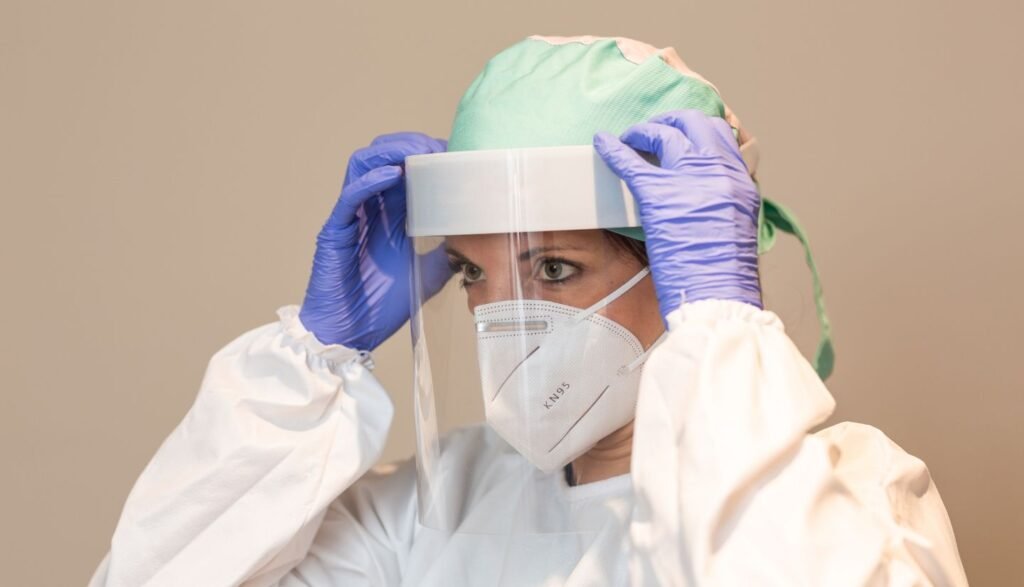In healthcare, stopping infections is a top priority. Germs can travel through the air, touch, and even clothing. This makes both patients and healthcare workers vulnerable.
Protective wear is one of the best ways to prevent infections. Items like gloves, masks, and gowns act as barriers, blocking harmful bacteria and viruses before they can spread.
In this blog, we’ll talk about the role of protective wear in stopping infections, the main types of gear, and simple tips for using them the right way. Whether you work in a hospital, clinic, or lab, these steps can help keep everyone safe.
Why Protective Wear Matters in Infection Prevention
Protective wear stops germs from reaching skin, clothes, and mucous membranes. This is important because infections can spread through small droplets in the air, direct contact, or contaminated surfaces.
The World Health Organization (WHO) and the Centers for Disease Control and Prevention (CDC) both recommend proper use of PPE in all healthcare settings.
When used the right way, Personal Protective Equipment (PPE) can prevent outbreaks, protect staff, and save lives.
For example, during flu season, surgical masks and gloves greatly reduce the spread of illness among staff and patients. In the COVID-19 pandemic, PPE became the first line of defense against the virus.
Key Types of Protective Wear and Their Functions
- Face Masks (Surgical, N95, KN95) – Protect against airborne germs and droplets. N95 masks filter at least 95% of airborne particles.
- Gloves (Sterile and Non-sterile) – Keep hands clean and prevent the spread of germs through touch. Sterile gloves are used in surgery, while non-sterile gloves are for general patient care.
- Gowns and Aprons – Protect skin and clothing from blood, fluids, and other contaminants.
- Caps and Hair Covers – Stop hair and scalp particles from contaminating sterile areas.
- Shoe Covers – Keep floors clean and prevent germs from being carried between rooms.
- Face Shields and Goggles – Protect eyes from splashes, sprays, and airborne debris.
Each of these items plays a specific role. Used together, they form a strong protection system in hospitals and clinics.
How to Use Protective Wear Effectively
Wearing PPE correctly is just as important as having it. If used the wrong way, it can fail to protect.
- Donning (Putting On) – Always put on Personal Protective Equipment (PPE) in the right order. For example: gown first, then mask, goggles, and gloves last.
- Doffing (Taking Off) – Remove gloves first, then goggles or face shield, gown, and mask last. This reduces the chance of touching contaminated surfaces.
- Right Size – PPE should fit properly. Loose masks or gloves that are too tight will not give full protection.
- Replace When Needed – If gloves tear or a mask becomes wet, change them immediately.
Common mistakes include touching the front of the mask, wearing the same gloves for multiple patients, and not washing hands before and after use.
Storage, Maintenance, and Disposal
- Storage – Keep PPE in clean, dry, and cool storage areas. Avoid damp or dusty conditions.
- Maintenance – For reusable PPE, follow manufacturer cleaning instructions.
- Disposal – Throw away single-use PPE immediately after use in the correct biohazard bins.
- Damage Check – Inspect PPE before use. If it’s torn, stained, or expired, do not use it.
Good storage and disposal practices ensure PPE works when needed and prevents contamination.
Protective Wear in Different Medical Settings
- Hospitals and Surgical Theatres – Full PPE for high-risk procedures, including gowns, masks, gloves, and eye protection.
- Clinics and Outpatient Care – Gloves and masks for patient contact, plus hand hygiene practices.
- Laboratories – Lab coats, gloves, and eye protection to prevent contact with chemicals and biological samples.
- Emergency Response – Quick-access PPE kits for rapid infection control in urgent situations.
Different settings require different PPE levels. Always follow your facility’s guidelines.
Training and Compliance
Protective wear is only effective if everyone knows how to use it. Staff training is key.
- Regular Training – Teach correct use, removal, and disposal of PPE.
- Checklists – Create PPE checklists for different roles and situations.
- Audits – Regularly check staff compliance.
- Leadership Role – Leaders should set the example by following PPE rules themselves.
Training ensures PPE is used correctly, every time.
Conclusion
Protective wear is more than just part of the uniform — it’s a lifeline. It keeps healthcare workers safe and stops infections from spreading to patients.
When PPE is used correctly, stored properly, and replaced when needed, it becomes one of the most effective tools in infection control.
Review your current PPE rules today. Check your supplies, train your staff, and make sure everyone understands the role of protective wear in stopping infections. A small step today can prevent a big problem tomorrow.



